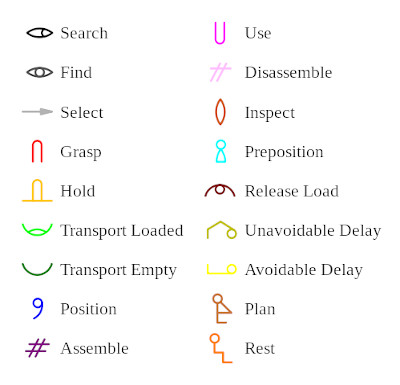In their early studies of time and motion, engineers Frank Bunker Gilbreth and Lillian Moller Gilbreth divided all motions of the hand into 17 varieties:

Magnificently, they called these therbligs, which is roughly Gilbreth spelled backward. “Transport empty” refers to receiving an item with an empty hand, “transport loaded” means moving an object with the hand, and so on. With careful study, a worker’s movements might be optimized to maximize speed and efficiency. (It was the Gilbreths, for example, who suggested that surgeons employ “caddies” to pass their instruments to them.)
This scheme makes an appearance in fiction: In their 1948 novel Cheaper by the Dozen, Frank and Lillian’s children Frank Jr. and Ernestine describe what it’s like to grow up in the home of an efficiency expert:
Suppose a man goes into a bathroom and shave. We’ll assume that his face is all lathered and that he is ready to pick up his razor. He knows where the razor is, but first he must locate it with his eye. That is ‘search’, the first Therblig. His eye finds it and comes to rest — that’s ‘find’, the second Therblig. Third comes ‘select’, the process of sliding the razor prior to the fourth Therblig, ‘grasp’. Fifth is ‘transport loaded’, bringing the razor up to his face, and sixth is ‘position’, getting the razor set on his face.
“There are eleven other Therbligs — the last one is ‘think’!”
